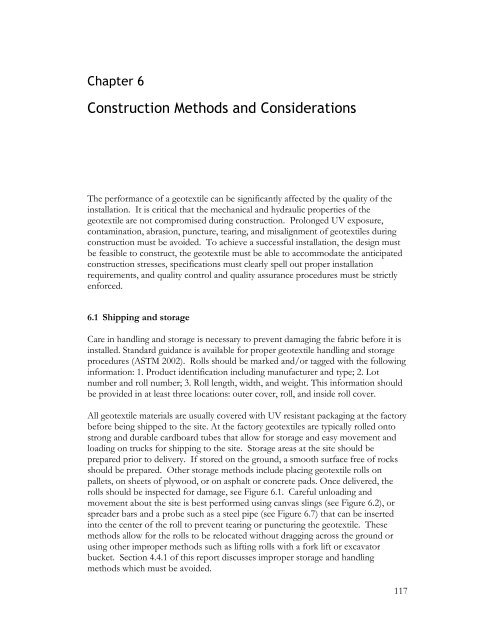Geotextiles in Embankment Dams - Association of State Dam Safety ...
Geotextiles in Embankment Dams - Association of State Dam Safety ...
Geotextiles in Embankment Dams - Association of State Dam Safety ...
You also want an ePaper? Increase the reach of your titles
YUMPU automatically turns print PDFs into web optimized ePapers that Google loves.
Chapter 6Construction Methods and ConsiderationsThe performance <strong>of</strong> a geotextile can be significantly affected by the quality <strong>of</strong> the<strong>in</strong>stallation. It is critical that the mechanical and hydraulic properties <strong>of</strong> thegeotextile are not compromised dur<strong>in</strong>g construction. Prolonged UV exposure,contam<strong>in</strong>ation, abrasion, puncture, tear<strong>in</strong>g, and misalignment <strong>of</strong> geotextiles dur<strong>in</strong>gconstruction must be avoided. To achieve a successful <strong>in</strong>stallation, the design mustbe feasible to construct, the geotextile must be able to accommodate the anticipatedconstruction stresses, specifications must clearly spell out proper <strong>in</strong>stallationrequirements, and quality control and quality assurance procedures must be strictlyenforced.6.1 Shipp<strong>in</strong>g and storageCare <strong>in</strong> handl<strong>in</strong>g and storage is necessary to prevent damag<strong>in</strong>g the fabric before it is<strong>in</strong>stalled. Standard guidance is available for proper geotextile handl<strong>in</strong>g and storageprocedures (ASTM 2002). Rolls should be marked and/or tagged with the follow<strong>in</strong>g<strong>in</strong>formation: 1. Product identification <strong>in</strong>clud<strong>in</strong>g manufacturer and type; 2. Lotnumber and roll number; 3. Roll length, width, and weight. This <strong>in</strong>formation shouldbe provided <strong>in</strong> at least three locations: outer cover, roll, and <strong>in</strong>side roll cover.All geotextile materials are usually covered with UV resistant packag<strong>in</strong>g at the factorybefore be<strong>in</strong>g shipped to the site. At the factory geotextiles are typically rolled ontostrong and durable cardboard tubes that allow for storage and easy movement andload<strong>in</strong>g on trucks for shipp<strong>in</strong>g to the site. Storage areas at the site should beprepared prior to delivery. If stored on the ground, a smooth surface free <strong>of</strong> rocksshould be prepared. Other storage methods <strong>in</strong>clude plac<strong>in</strong>g geotextile rolls onpallets, on sheets <strong>of</strong> plywood, or on asphalt or concrete pads. Once delivered, therolls should be <strong>in</strong>spected for damage, see Figure 6.1. Careful unload<strong>in</strong>g andmovement about the site is best performed us<strong>in</strong>g canvas sl<strong>in</strong>gs (see Figure 6.2), orspreader bars and a probe such as a steel pipe (see Figure 6.7) that can be <strong>in</strong>serted<strong>in</strong>to the center <strong>of</strong> the roll to prevent tear<strong>in</strong>g or punctur<strong>in</strong>g the geotextile. Thesemethods allow for the rolls to be relocated without dragg<strong>in</strong>g across the ground orus<strong>in</strong>g other improper methods such as lift<strong>in</strong>g rolls with a fork lift or excavatorbucket. Section 4.4.1 <strong>of</strong> this report discusses improper storage and handl<strong>in</strong>gmethods which must be avoided.117
















